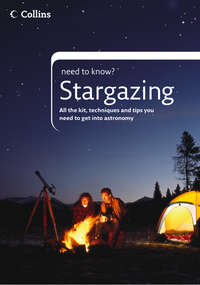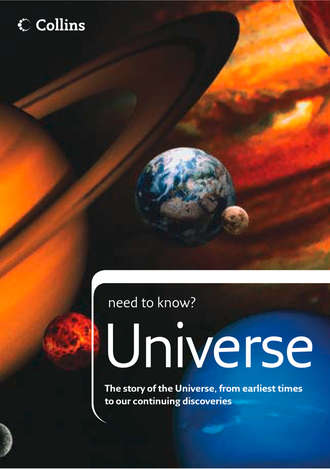
Полная версия
Universe: The story of the Universe, from earliest times to our continuing discoveries
In the 3rd century BC, Eratosthenes applied trigonometry to determine that the Earth is a sphere measuring around 40,000km in circumference, a remarkably accurate feat achieved by observing the length of the shadow cast by the Sun at noon from two widely separated places (Aswan and Alexandria) whose separation was known.
A contemporary of Eratosthenes, Aristarchus used geometry to calculate the sizes and distances of the Moon and the Sun. By observing the Moon’s half-phases and the angles made by the Earth, Sun and Moon, Aristarchus concluded that the Sun was 19 times further away than the Moon (the Sun’s actual distance is 400 times that of the Moon). He observed the Moon passing through the Earth’s shadow during lunar eclipses and concluded that the Moon was half the Earth’s size.
Hipparchus, working in the 2nd century BC, made accurate measurements of the orbit, distance and size of the Moon, and determined the distance of the Sun. Using an accurately constructed naked eye measuring device called an astrolabe, he observed and recorded the co-ordinates of around 850 stars to compile a star catalogue. Another major star catalogue was compiled in the 2nd century AD by Ptolemy, who included it in an encyclopedia of ancient Babylonian and Greek knowledge.
must know
Very little is known of Ptolemy’s life. He made astronomical observations from Alexandria in Egypt during the years 127–41 AD. The first of Ptolemy’s observations can be dated to 26 March 127, while his last known observation was made on 2 February 141.
Solar hub
Ptolemy’s Earth-centred view of the Universe held sway in the west for around 1,500 years. Credit for the idea that the Sun, not the Earth, lies at the centre of the Solar System is often given to Nicolaus Copernicus (1473–1543).
Copernican revolution
Heliocentric (Sun-centred) theories can actually be traced back to ancient Greece, to philosophers Pythagoras, Philolaus and Aristarchus. However, in 1514 Copernicus was bold enough to produce a small handwritten pamphlet (but canny enough not to put his name to it) which challenged the very fundamentals of Ptolemy’s geocentric (Earth-centred) view of the Universe. Copernicus stated that the stars are at an immense distance, compared to the distance from the Earth to the Sun. He was convinced that the Sun, not the Earth lay near the centre of the Universe, and that the apparent daily rotation of the heavens is caused by the Earth’s rotation. Copernicus went on to explain that the apparent annual circuit of the Sun around the ecliptic is caused by the Earth revolving around the Sun, and the apparent retrograde motion of the planets is caused by the motion of the Earth along an orbit inside that of the outer planets.
His explanation of the phenomenon of retrograde motion, and dispensing with the need to introduce epicyclic planetary motions, is perhaps the most insightful and original of Copernicus’ theories. Copernicus later laid out his potentially heretical heliocentric views of the Universe in his book On the Revolutions of the Heavenly Bodies, one of the first copies of which was given to him as he lay dying in 1543.
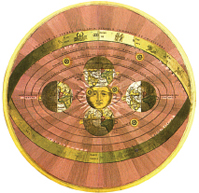
Placing the Sun at the centre of the Solar System, Copernicus’ heliocentric theory saw the Earth as one of six orbiting planets.
Copper-nosed enquirer
Tycho Brahe (1546–1601) is regarded as the last and greatest astronomer of the pre-telescopic era. A hot-headed Danish nobleman, Tycho lost part of his nose in a sword duel and later replaced it with a copper prosthesis. In an attempt to refute Copernicus’ view of the Universe, Tycho began making precise measurements of the stars and the movements of the planets with the aid of quadrants and cross-staffs from his observatory at Uraniborg on the island of Hven. Tycho’s careful naked-eye observations went on to provide plenty of evidence disproving the old established notions of the Earth-centred Universe.
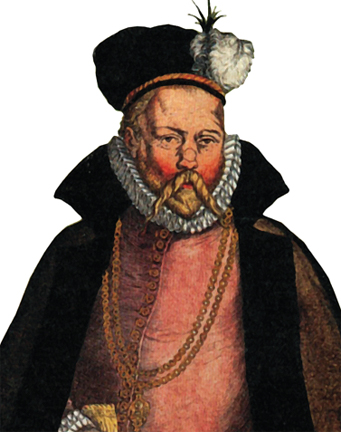
Tycho Brahe, a great pretelescopic astronomer. He used naked eye devices to make incredibly accurate observations of planetary motions.
Understanding the Solar System
In the early 17th century, a potent combination of theory and observation expanded human notions about the Universe. The telescope opened everyone’s eyes to the cosmos.
Kepler, planetary law-giver
Despite finding evidence to support the idea that the Earth was a planet in orbit around the Sun, Tycho Brahe remained highly skeptical of the idea. He clung to the old notion of an Earth-centred Universe whose motions would eventually be explained as soon as the right mathematical model was found. Tycho’s assistant, Johannes Kepler (1571–1630), had none of his teacher’s confidence in the geocentric theory, and used Tycho’s extensive observations to place the heliocentric theory on a firm scientific footing. Profoundly religious, Kepler was convinced that God had created the Universe in accordance with mathematical rules, and that a knowledge of these rules was within human comprehension.
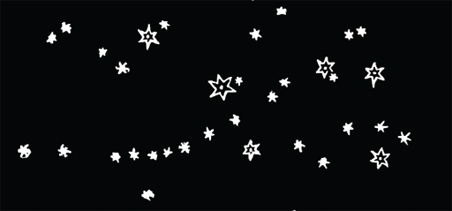
Galileo’s telescopic observation of the Pleiades. Only a handful of stars in this cluster can be seen with the unaided eye.
Telescopic revelations
Having heard about a newly invented optical instrument that made distant objects appear larger, Galileo Galilei, a professor of mathematics at Padua University, ground and polished lenses to make small telescopes of his own by the end of 1609. Although a number of people had used telescopes in the months before Galileo placed his own eye to the eyepiece, Galileo is acknowledged to have been the first to turn the telescope to the skies to make scientific observations.
Anyone recalling their first telescopic views of the Moon and planets might conjure up some idea of how Galileo must have felt when he made his first observations through the telescope in 1609–10. Galileo’s telescopes consisted of two lenses mounted at either end of a tube – a plano-convex objective lens of about 30mm diameter at the front end to collect and focus light, and a smaller planoconvex eye lens at the other end to focus and magnify the image so that it can be viewed. Such an instrument is the most basic form of refracting telescope, yet despite it performing little better than today’s toy telescopes, Galileo gained amazing insights into the nature of the Universe. He discovered four small satellites orbiting Jupiter, which are still referred to as the Galilean Moons. Venus displayed phases, proving that it was a globe in orbit around the Sun. Sunspots proved that our central star is by no means perfect, and the Moon’s surface was revealed as a world with dark plains, craters and high mountains. Delving into deep space, Galileo observed that the glowing band of the Milky Way was made up of multitudes of faint stars.
must know
In the early 17th century Kepler formulated his famous laws of planetary motion, which stated that the planets orbit the Sun along elliptical paths and that they move faster when nearest to the Sun.
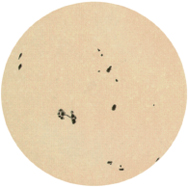
An observation of the Sun made by Galileo in July 1613 shows detail within sunspot groups.
The orbs around us
During the 17th century, as telescopes improved, an increasing number of scientists and amateur astronomers were keen to learn more about the Universe by scrutinising celestial realms previously hidden from human view.
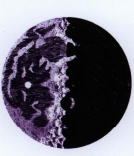
The Moon and its craters, from an observation made by Galileo in November 1609.
Reality bites
People began to question the workings of the Universe, and they now had optical tools with which to study the heavens more closely. Yet, despite the evidence, there were many who did not accept the reality of what the newly invented telescope revealed about the Universe. Some had seen the power of the telescope with their own eyes but believed that it was trickery or the work of the devil. Galileo and others who supported the Copernican view that the Earth was a planet in orbit around the Sun were denounced as heretics. Even Galileo succumbed to pressure when he was asked by the Inquisition to refute the idea.
Our lunar companion
The Moon is so big and bright that plenty of detail can be seen on its surface through even the most basic optical equipment – a fact that has delighted lunar observers from Galileo to the present day. It is not surprising that many early telescopic observers chose to study the Moon, to draw its features and to map its surface. The Moon’s landscape really did resemble parts of the Earth – Galileo had likened it to parts of Bohemia – so did it have an atmosphere and could it support life? Large dark patches visible with the unaided eye were discovered to be relatively flat grey plains. These areas became known as ‘maria’ (Latin: seas), but it was plain to see through the telescope eyepiece that they did not represent bodies of water.
The mid-17th century saw the publication of a number of detailed lunar maps. One by Johannes Hewelke (Hevelius) was published in his Selenographia, complete with names for lunar features based upon geographical landmarks, like Sicily, Mount Etna and the Mediterranean Sea. From his private observatory, Hevelius also made accurate measurements of star positions and produced the Uranographica, the most advanced star atlas of its time; the names for his seven new constellations are still used by astronomers today.
At around the same time, Giovanni Riccioli published an accurate lunar map which incorporated nomenclature that is still current, including his names for the Moon’s seas, such as Mare Tranquillitatis (the Sea of Tranquillity) and many of the larger craters like Copernicus (Mount Etna on Hevelius’ map) – familiar names to modern watchers of the Moon.
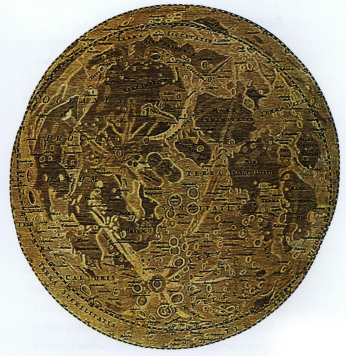
Giovanni Riccioli’s Moon map of 1651.
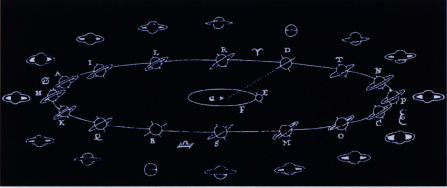
Christiaan Huygens’ explanation of Saturn’s rings and their changing appearance.
Planetary perceptions
Fresh telescopic revelations answered some age-old questions about our immediate planetary neighbourhood but raised many more new ones.
Aerial adventures
In the Netherlands, Christiaan Huygens constructed lengthy refracting telescopes whose lenses were suspended on frames in the air and moved by means of ropes and pulleys. Such unwieldy devices – some of them measuring more than 8om (260ft) from objective lens to eyepiece – were required to overcome a defect inherent in simple optics known as chromatic aberration. Caused by the inability of a single objective lens to focus all the colours within white light to a single point, chromatic aberration causes bright objects to appear surrounded by coloured fringes. The longer the objective lens, the less evident the degree of aberration. Huygens also improved eyepiece design by introducing the twolensed Huygenian ocular – a design still provided today with many budget telescopes. Using these ungainly aerial telescopes he discovered Jupiter’s equatorial bulge – the consequence of Jupiter’s rapid spin and its gaseous composition. Bright polar caps were discovered on Mars, in addition to a dark V-shaped feature known as Syrtis Major. Almost half a century after Galileo had discovered the Solar System’s first planetary satellites, Huygens discovered Saturn’s largest satellite, Titan, in March 1655. A conundrum which had baffled astronomers since Galileo – mysterious appendages that seemed to cling to Saturn’s side and vary in size over the years – was finally solved by Huygens, who explained that Saturn had a flat ring system that nowhere touched the planet.
Конец ознакомительного фрагмента.
Текст предоставлен ООО «ЛитРес».
Прочитайте эту книгу целиком, купив полную легальную версию на ЛитРес.
Безопасно оплатить книгу можно банковской картой Visa, MasterCard, Maestro, со счета мобильного телефона, с платежного терминала, в салоне МТС или Связной, через PayPal, WebMoney, Яндекс.Деньги, QIWI Кошелек, бонусными картами или другим удобным Вам способом.




